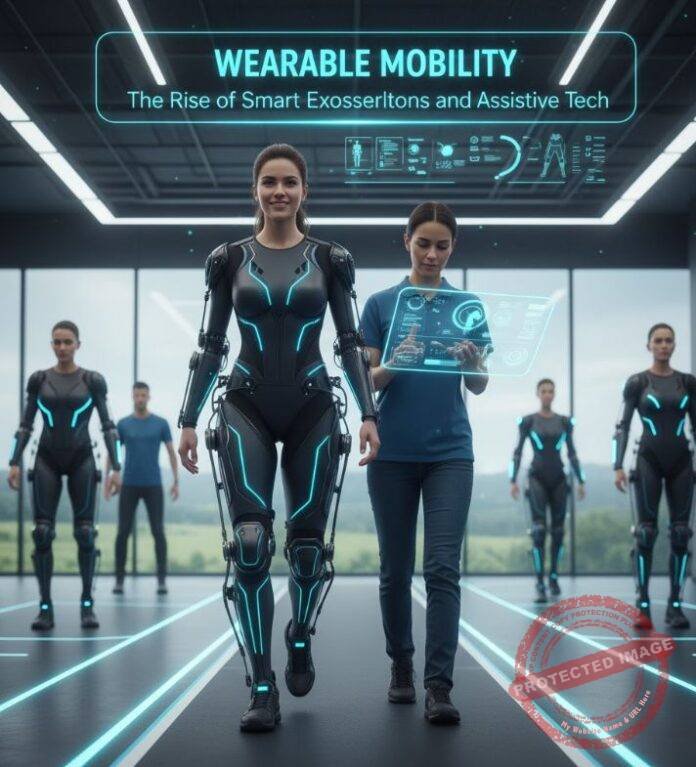How Robotics, AI, and Human-Centered Design Are Empowering Movement, Independence, and the Future of Work.
The New Age of Wearable Mobility
Technology is no longer just something we carry—it’s something we wear. From fitness trackers and AR glasses to robotic suits that amplify strength, wearable mobility devices are transforming how humans move, heal, and perform.
What began as medical rehabilitation tools has evolved into a powerful new category of assistive and augmentative technology. Today, smart exoskeletons and wearable robotics are helping patients walk again, workers lift safely, and soldiers move with enhanced endurance.
This convergence of engineering, biomechanics, and AI is redefining the boundaries of human motion.
Exoskeletons: From Sci-Fi to Factory Floor
Once the stuff of science fiction, exoskeletons have moved from the lab to real-world applications. These robotic frameworks—worn externally to support or enhance movement—are now deployed across healthcare, logistics, defense, and manufacturing.
Modern exoskeletons come in two main types:
-
Passive: Lightweight, mechanical systems that redistribute weight and reduce strain.
-
Active: Powered by electric or hydraulic systems controlled by sensors and AI for precision movement.
Companies like Ekso Bionics, Sarcos Robotics, and Cyberdyne are leading the charge—developing wearable systems that augment human capability while preventing injury and fatigue.
Empowering Rehabilitation and Recovery
In healthcare, wearable mobility technology is changing lives. AI-powered exoskeletons are helping patients with spinal cord injuries, strokes, and degenerative diseases regain mobility and independence.
These systems analyze muscle movement and brain signals to create adaptive motion assistance that aligns with each user’s physical ability. Combined with real-time feedback, they accelerate rehabilitation and restore confidence.
Hospitals and therapy centers worldwide are now integrating these systems into clinical practice—bridging the gap between robotics and human resilience.
Workplace Applications: Enhancing Human Performance
Wearable mobility isn’t just about recovery—it’s about reinventing productivity.
In warehouses, factories, and construction sites, exoskeletons reduce physical strain by supporting posture and amplifying lifting capacity. Workers can perform repetitive or heavy tasks with less fatigue and lower risk of injury.
For industries facing labor shortages and aging workforces, wearable robotics represent a sustainable solution—one that keeps workers safe, efficient, and employable longer.
The fusion of ergonomics and automation is creating a future where humans and machines work in seamless symbiosis.
AI and Sensor Intelligence: The Nervous System of Wearable Tech
Modern wearable mobility devices rely on sophisticated AI and sensor networks to interpret and respond to human motion.
-
Inertial Measurement Units (IMUs) track movement and orientation.
-
Force and pressure sensors detect weight distribution and exertion.
-
AI algorithms predict motion intent and adjust mechanical support in real time.
-
Edge computing enables instant feedback without cloud dependency.
This adaptive intelligence allows devices to learn from each user, creating personalized motion profiles that evolve with experience—essentially turning the exoskeleton into an extension of the body.
Accessibility and Assistive Innovation
Beyond industry and rehabilitation, wearable mobility is expanding accessibility for individuals with disabilities.
Innovations such as smart prosthetics, powered wheelchairs, and mobility-assist exosuits empower users with autonomy and social inclusion.
Meanwhile, lightweight designs and affordability improvements are making these technologies available to broader populations. Startups and research labs are working toward the vision of mobility for all, blending compassion with cutting-edge engineering.
Challenges and Ethical Considerations
The rise of wearable mobility raises important questions:
-
Affordability: Can these technologies reach those who need them most?
-
Ethics: How do we balance augmentation with equality and fairness in the workplace?
-
Privacy: Wearable systems that collect biometric data must ensure user consent and secure storage.
-
Regulation: Safety standards and certifications must evolve with innovation.
As with all transformative technologies, progress must be matched by responsible design and policy frameworks that protect both users and society.
Closing Thoughts and Looking Forward
Wearable mobility represents a convergence of human potential and machine intelligence. From healthcare to heavy industry, these technologies are enabling people to do more—safely, sustainably, and inclusively.
As AI, materials science, and robotics continue to advance, wearable mobility devices will become lighter, smarter, and more intuitive—eventually disappearing into our daily lives like any other accessory.
The future of mobility isn’t about machines replacing humans—it’s about machines empowering humanity to move beyond limits.
References
-
“Exoskeletons and the Future of Human Mobility” – World Economic Forum
https://www.weforum.org/agenda/2024/07/exoskeletons-and-the-future-of-human-mobility -
“The Role of AI in Wearable Robotics” – MIT Technology Review
https://www.technologyreview.com/2024/09/21/the-role-of-ai-in-wearable-robotics -
“How Exoskeletons Are Transforming the Workplace” – McKinsey & Company
https://www.mckinsey.com/capabilities/operations/our-insights/how-exoskeletons-are-transforming-the-workplace -
“Assistive Technology and Inclusive Design in the Digital Age” – Deloitte Insights
https://www.deloitte.com/insights/assistive-technology-and-inclusive-design -
“Ethics and Accessibility in Wearable Mobility Tech” – Forbes Tech Council
https://www.forbes.com/sites/forbestechcouncil/2024/10/10/ethics-and-accessibility-in-wearable-mobility-tech
Author: Serge Boudreaux – AI Hardware Technologies, Montreal, Quebec
Co-Editor: Peter Jonathan Wilcheck – Miami, Florida
Post Disclaimer
The information provided in our posts or blogs are for educational and informative purposes only. We do not guarantee the accuracy, completeness or suitability of the information. We do not provide financial or investment advice. Readers should always seek professional advice before making any financial or investment decisions based on the information provided in our content. We will not be held responsible for any losses, damages or consequences that may arise from relying on the information provided in our content.



